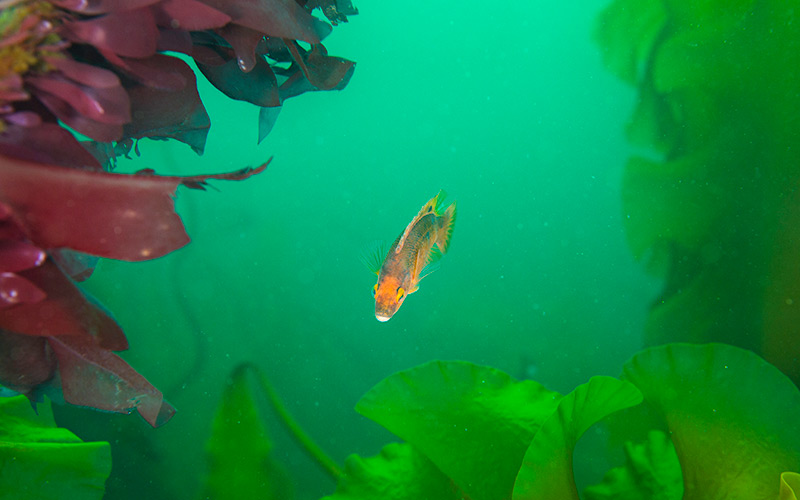
A fish swims amid kelp in Cashes Ledge. Photo: Brian Skerry
Far out into the Gulf of Maine, a thriving cradle of marine biodiversity overflows with life. Cashes Ledge is an underwater mountain range that nurtures a multitude of species, many of them vulnerable to human impacts as well as climate change. It’s an irreplaceable habitat, a living laboratory, a refuge in a warming ocean – and last year, I got to visit.
I’ve spent a lot of time at sea, but this was my first chance to join a research expedition since joining CLF as a marine scientist. I was excited by the chance to see this important area up close and personal. Cashes Ledge features steep peaks, muddy basins, rocky fields, and dense kelp forests, encompassing all the key types of seafloors that the offshore Gulf of Maine has to offer.
I’ve worked in a lot of far-flung places, studying sea butterflies in the North Pacific, tagging elephant seals off California, tracking krill in the Antarctic, and tackling a variety of research topics in our local waters of the Gulf of Maine – but even amongst all those cool places, Cashes Ledge stands out as special.
Despite its ecological value and importance to New England, Cashes Ledge is not fully or permanently protected. Some kinds of fishing are still allowed in its waters. Current policies could even permit industrial activity. That’s why CLF is pushing to make Cashes Ledge a national marine sanctuary, which will provide strong, permanent protections. Add your name to our list of Cashes Ledge supporters to send a message that you believe in preserving this extraordinary area for future generations.
Today, I want to share just four of the amazing lifeforms we encountered in my four days on our research expedition to Cashes Ledge. While I didn’t dive myself, I saw many magnificent animals on the surface and listened as the divers reported their incredible finds. I can’t capture the full majesty of the region for you, but hopefully, this will give you a taste of why Cashes is a treasure that we must protect for future generations.
1. Humpback whales
On my very first morning out on Cashes, which happened to be World Oceans Day, a pod of humpback whales fluked (showed us their tails) for an hour near our research vessel. It was an amazing welcome to the area. Minke, fin, endangered sei whales, and critically endangered North Atlantic right whales also find refuge in Cashes Ledge.
Sadly, we didn’t see any North Atlantic right whales, but I wasn’t surprised – there are barely 360 left in the world.
2. Kelp
If you think kelp is just a boring seaweed, you haven’t seen what they’ve got growing out at Cashes Ledge. Cashes has the deepest and densest kelp forest in the Northwest Atlantic, vast underwater fields teeming with life. The divers brought up multi-colored fronds of sugar and horsetail kelp up to 10 feet in length.
Kelp are what we call ‘habitat forming’ or ‘ecosystem engineer’ species. Much like the trees in a forest on land, the kelp at Cashes Ledge provides a crucial habitat and feeding opportunities for a wide range of marine life, including pollock, rare Atlantic wolffish, and the iconic New England cod.
Speaking of which …
3. Atlantic cod
The divers spotted lots of large Atlantic cod, which was wonderful to hear. Cod are a highly vulnerable species, with numbers hovering at record lows. Overfishing along with warming waters has pushed the populations to the brink.
Seeing bigger cod is especially heartening. Older female fish, what scientists colorfully call Big Old Fat Fertile Female Fish (BOFFFFs), produce exponentially more eggs than younger fish and so are especially important to rebuilding the populations. You can learn more about the critical role that BOFFFFs and protecting key habitat play in the survival and recovery of cod via CLF’s fun comic on the topic.
4. Lobster
When the divers surfaced and told me they had spotted the biggest lobster they had ever seen, I was impressed (they’ve seen a lot of crustaceans!) but not surprised. Cashes Ledge provides a haven for lobster.
Unfortunately, climate change is warming the Gulf of Maine faster than 97% of the world’s oceans, and lobster are among the many kinds of marine life struggling to keep up. We know, though, that healthier ecosystems with a broad diversity of plants and animals are better equipped to deal with the stress of climate change. Protecting the incredibly diverse Cashes Ledge from additional human impacts will help us build climate resilience in the region.
To see more of Cashes Ledge, I encourage you to check out this video featuring some of the area’s other highlights:
Hopefully, this has given you a stronger understanding of what Cashes Ledge is and what wonders it holds. In addition to providing a home to all these species, keeping Cashes Ledge preserved as a living laboratory for scientists to study will give us all an edge in the fight to preserve the ocean from climate change. We need to give sanctuary status to Cashes Ledge to protect those wonders for future generations.



